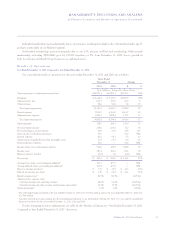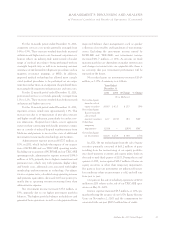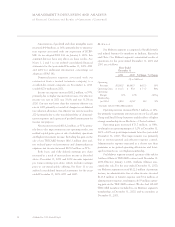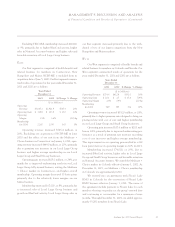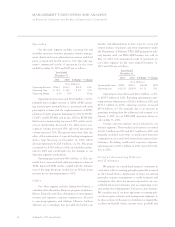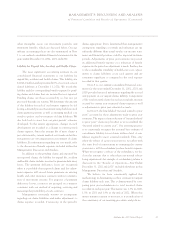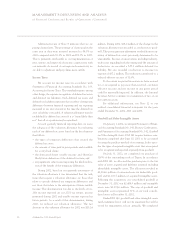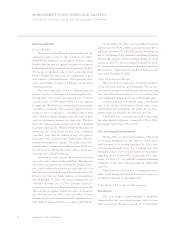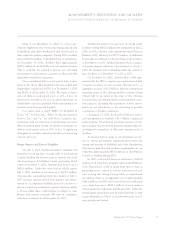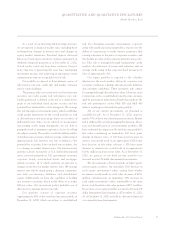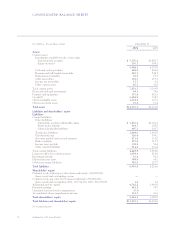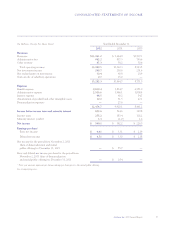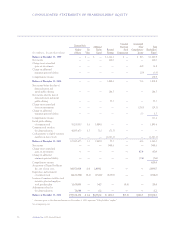Anthem Blue Cross 2002 Annual Report Download - page 53
Download and view the complete annual report
Please find page 53 of the 2002 Anthem Blue Cross annual report below. You can navigate through the pages in the report by either clicking on the pages listed below, or by using the keyword search tool below to find specific information within the annual report.
MANAGEMENT’S DISCUSSION AND ANALYSIS
of Financial Condition and Results of Operations (Continued)
48 Anthem, Inc. 2002 Annual Report
Additional review of Note 8 indicates that we are
paying claims faster. The percentage of claims paid in the
same year as they were incurred increased to 84.3% in
2002 compared with 83.1% in 2001 and 81.3% in 2000.
This is primarily attributable to our implementation of
new systems and improved electronic connectivity with
our networks. As a result of our improved connectivity we
are able to adjudicate and pay claims more swiftly.
Income Taxes
We account for income taxes in accordance with
Statement of Financial Accounting Standards No. 109,
Accounting for Income Taxes. This standard requires, among
other things, the separate recognition of deferred tax assets
and deferred tax liabilities. Such deferred tax assets and
deferred tax liabilities represent the tax effect of temporary
differences between financial reporting and tax reporting
measured at tax rates enacted at the time the deferred tax
asset or liability is recorded. A valuation allowance must be
established for deferred tax assets if it is “more likely than
not” that all or a portion may be unrealized.
At each quarterly financial reporting date, we assess
the adequacy of the valuation allowance by evaluating
each of our deferred tax assets based on the key elements
that follow:
•the types of temporary differences that created the
deferred tax asset;
•the amount of taxes paid in prior periods and available
for a carry-back claim;
•the forecasted future taxable income and therefore
likely future deduction of the deferred tax item; and
•any significant other issues impacting the likely realiza-
tion of the benefit of the temporary differences.
During 2002, based on our quarterly assessments of
the valuation allowance it was determined that the only
items that require a valuation allowance are those that
relate to specific deferred tax temporary differences and
not those that relate to the anticipation of future taxable
income. This determination was due to the levels of tax-
able income reported on our 2001 tax return, income
generated during 2002 and taxable income expected in
future periods. As a result of this determination, during
2002, we reduced our valuation allowance. The net
decrease in the valuation allowance for 2002 was $112.4
million. During 2002, $18.0 million of the change in the
valuation allowance was recorded as a reduction to good-
will. This postacquisition adjustment resulted from recog-
nition of deferred tax assets previously determined to be
unrealizable. Because of uncertainties including industry-
wide issues regarding both the timing and the amount of
deductions, we recorded a $57.2 million deferred tax
liability. We also recorded a reduction to income tax
expense of $37.2 million. This reduction contributed to a
reduced effective tax rate of 31.6%.
To the extent we prevail in matters we have accrued
for or are required to pay more than reserved, our future
effective tax rate and net income in any given period
could be materially impacted. In addition, the Internal
Revenue Service continues its examination of two of our
five open tax years.
For additional information, see Note 12 to our
audited consolidated financial statements for the years
ended December 31, 2002, 2001 and 2000.
Goodwill and Other Intangible Assets
On January 1, 2002, we adopted Statement of Finan-
cial Accounting Standards No. 141, Business Combinations,
and Statement of Accounting Standards No. 142, Goodwill
and Other Intangible Assets. FAS 141 requires business com-
binations completed after June 30, 2001 to be accounted
for using the purchase method of accounting. It also speci-
fies the types of acquired intangible assets that are required
to be recognized and reported separately from goodwill.
On July 31, 2002, we completed our purchase of
100% of the outstanding stock of Trigon. In accordance
with FAS 141, we allocated the purchase price to the fair
value of assets acquired and liabilities assumed, including
identifiable intangible assets. The allocation resulted in
$2,166.6 million of estimated non-tax deductible good-
will and $1,172.7 million of acquired intangible assets.
Following this acquisition, our consolidated goodwill at
December 31, 2002 was $2,484.9 million and intangible
assets were $1,274.6 million. The sum of goodwill and
intangible assets represented 31% of our total consoli-
dated assets at December 31, 2002.
Under FAS 142, goodwill and other intangible assets
(with indefinite lives) will not be amortized but will be
tested for impairment at least annually. We completed





